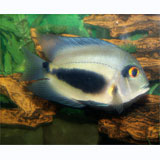
Scientific Name: uaru amphiacanthoides
Origin: South America
Family: Cichlidae
Other Names: Triangle Cichlid
Technical Info
Temperature: 24 - 28 ℃
pH: 6.8 - 7.2
GH: 8 - 12
Max size: 26 cm
Min Tank size: 300 Ltr
Position in Aqua: No special swimming level
Description
Uaru amphiacanthoides, whose common name is the Uaru, is one of the medium to large New World Cichlids. There are actually two species of Uaru, Uaru amphiacanthoides and the Uaru imperialis, both rarely exported. This article will concentrate on the former and the more common. Although the Uaru can attain sizes up to 30 cm or so, it is rare to see one over 25 cm. The coloration of the adult Uaru is rather bland. They are greenish brown with a little black along their sides. But when spawning time comes along they color up magnificently. The whole sides of their bodies turn black leaving just a little brown around the edges and their eyes brighten to a coppery red color as if someone turned on a light inside their heads.
Food
The Uaru will eat just about anything. They will eat flake foods, pellets, worms, or any type of vegetable matter that you have around. They love aquarium plants and will eat them down to the roots. Baby Uarus, when newly hatched, will eat the slime from their parents sides. After about two weeks they will eat a finely granulated flake or newly hatched brine shrimp or anything else they can it into their mouths. They are incredibly fast growers. The fry pictured with their parents are four weeks old. The parents are about 8 inches to compare size.
Breeding
Uarus have always had the rap as being extremely difficult to breed. They certainly aren’t like convicts but most aquarists can accomplish the mission at hand. You know what they say about patience being a virtue. The best way to sex them is to let them pair off on their own. Keep about six or eight in a large tank and they will do the rest. Remove the other fish and you have a pair. Uarus’ are substrate spawners and will lay from 100 to 800 eggs at a time, maybe more. They will spawn on the floor of a tank, on a piece of slate or in a large flowerpot. They, like most South American cichlids, will tend to their young if in a separate tank from other fish. If you keep the fry in too long, they will disappear. If they spawn in a community tank, you will have a hard time separating the fry from the parents. If they spawn in a community tank, siphon the wrigglers out using airline tubing.
Compatible with
Uaru prefer warmer water than many other tropicals, and do well with rummynose tetras, some plecos, severums, corydoras, altum angels, rams, and geophagus to name a few.





